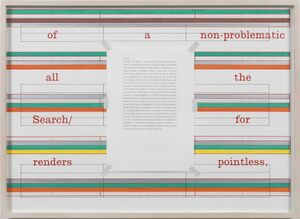Letters to the Red Crayola VIII, 1973-2012
| Letters to the Red Crayola VIII, 1973-2012 | |
|---|---|
 | |
| Art & Language | |
| Project | |
| Year | 2012 |
| Dimensions | 42.5 × 62.7 cm[1] |
| Materials | Ink, acrylic, collage and mixed media on paper |
Text
Dear M. Yes, there were 'Hostages' paintings in the form of palettes, their bright and messy brushstrokes intersected by fragmentary images of the Whitney Museum and bits of fake plywood. They pretend to a sort of autonomy — a virtual personality or something. While we spend much of our time actually taking intellectual cues from Adorno (or, like the 'Hostage' picture, pretending to) we're never quite sure how far to go. It seems more or less analytic to us that art must, given the present dispensations, aspire to the condition of autonomy if it is to sustain any kind of negatively dialectical (or simply negative) relation with the commodity fetish. There is some urgency in the premise (if an artistic project can have a premise). Of course, while it's still urgent to try to recover some sense of artistic autonomy, the official metaphysics of personal autonomy has changed. Personal autonomy was and remains an intellectual cornerstone of Human Rights but Cultural Studies and French Theory have continuously decentred and re-made or re-invented all of us with unremitting prejudice. The personalities that are remodelled on a regular and commercial scale are no longer benighted and fucked up, but strangely virtuous and lucky. For an aesthetics that draws comparisons — and indeed makes very strong analogies — between the autonomy of the person and the autonomy of the work of art, the moral and psychological migration of the radically (or irritatingly or implausibly) discontinuous presents something of a problem. The task of re-inventing autonomy is urgent and interesting but it will always be a flickering sign. Perhaps it always was.
Interpretations
- The text references Hostage (1988)